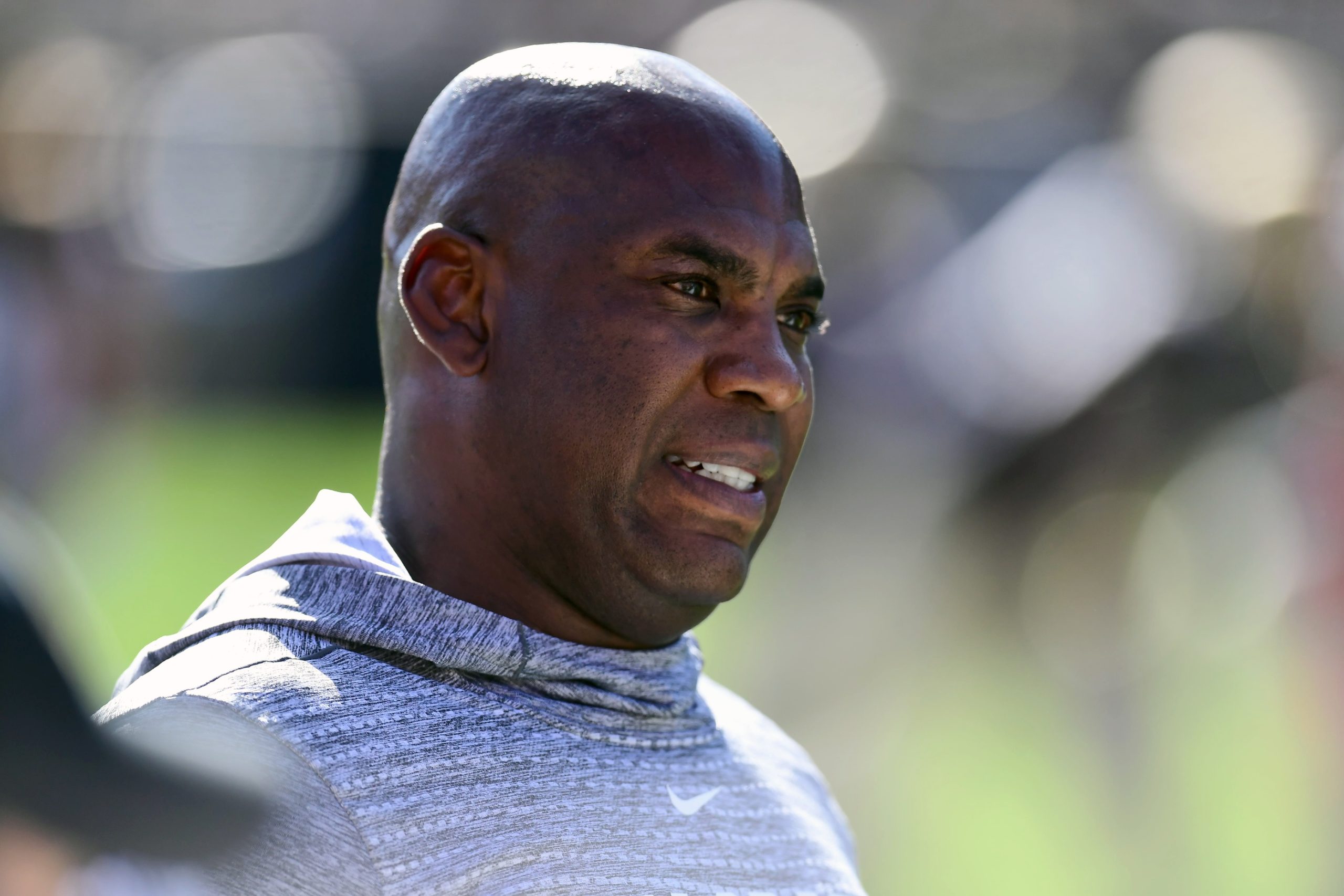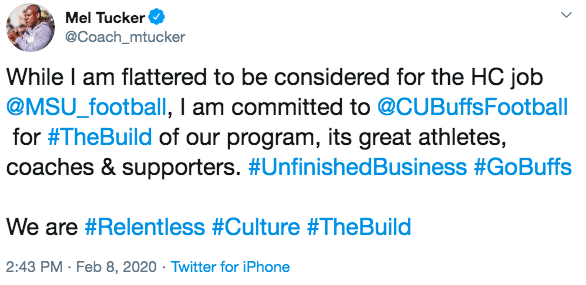Ad Disclosure

Michigan State’s surprising poach of Mel Tucker speaks volumes about the current state of college football
At 7 a.m. on Wednesday morning, I did what I always do — I woke up and checked Twitter. Thanks to the brave, around-the-clock news gatherers like Bruce Feldman, Adam Rittenberg and Colton Pouncy, I saw that Michigan State poached Mel Tucker from Colorado and agreed to a deal to bring him to East Lansing.
In my groggy state, I was a bit confused. Less than a week ago, Tucker publicly turned down the offer and said that he was staying in Boulder after Year 1 as the Buffs’ head coach.
Check that. Just 3.5 days ago* was when Tucker publicly turned down MSU’s offer, despite the fact that his coaching career started at MSU and he’s a Cleveland native with Midwest ties. Along with Cincinnati’s Luke Fickell, Iowa State’s Matt Campbell, Pitt’s Patt Narduzzi and the San Francisco 49ers’ Robert Saleh, MSU reportedly received 5 rejections in a week after Mark Dantonio announced his retirement (during which he claimed that people were going to “crawl” to MSU to replace him).
I, like the rest of America, went to bed on Tuesday night knowing that MSU was desperate and beginning to run out of options. When I woke up to see the Tucker news all over my feed, it took a minute for the “why” to register. Or perhaps I should call it the “how.” As in, how in the world did MSU circle back and get Tucker to accept a job that he turned down 3.5 days ago? Surely the initial money offered would’ve already been a significant raise.
Then I read this paragraph in Feldman’s column on the move and it all made sense (via The Athletic):
People with knowledge of Tucker’s deal with the Spartans said it doubles his Colorado coaching salary pool (which was $3.15 million in 2019), includes a substantial increase to the Michigan State strength and conditioning staff budget and program resources and will more than double Tucker’s Colorado salary, which is around $2.7 million.
In other words, MSU backed up the Brinks truck. Big time.
It’s almost like the Spartans administration played all of their cards and then remembered that it dropped a card on the floor. That card was like, “wait a minute. We’re in the B1G. You know, the conference with $759 million in annual revenue distribution last year. Now would be a good time to play this card.”
And play it, they did. If that doesn’t speak to the current state of the Power 5 imbalance, I don’t know what does.
This offseason, we saw 2 Pac-12 coaches (Mike Leach and Tucker) leave for jobs at Mississippi State and Michigan State. Both of them reportedly agreed to deals that will pay them north of $5 million per season. How many Pac-12 coaches made that much in 2019, you ask? None. How many B1G and SEC coaches made that much in 2019, you ask? Ten.
Shoot, Northwestern and Purdue are paying their respective head coaches north of $5 million. Let me repeat that — Northwestern and Purdue are paying more money for their head coaches than ANY Pac-12 team. Now Michigan State is in that club.
Money talks. Money convinced Leach to drop his Key West vacation plans to go to Starkville. Money convinced Tucker to drop his Colorado donor tour and go clean up the mess that Dantonio left in East Lansing (it is still a mess with a significant gap in talent). And while money wasn’t the only thing that swayed Tucker, what else changed during those 3.5 days?
Because of that, Tucker is going to take a lot of heat. It doesn’t help that this was the same guy who said “there’s no transfer portal in the real world” during his 1 and only season in Boulder, nor does it help that this tweet will forever live in Old Takes Exposed infamy:
Yikes. When people say “this is why you can’t ever trust college football coaches,” this is exactly what they’re talking about (let those Colorado players transfer and play immediately if they choose).
I’ll say this, though. In Tucker’s defense, that was before MSU came at him with the offer that was going to more than double his Colorado salary. Think about this. Here’s a guy who made $1.5 million as Georgia’s defensive coordinator as recently as 2018. That was 20 years into his coaching career. Roughly 14 months removed from that salary, he’s going to make close to 4 times as much as that.
It’s life-changing money that MSU threw at him. That’s why he couldn’t refuse it.
For a second, though, let’s think about how incredible it is that the Spartans could come over the top that strongly. Here’s a school coming off a pair of rather mediocre seasons who just had its head coach accept a $4.3 million retention bonus and then retire weeks later amidst alleged NCAA violations. Yet still, MSU went out and offered Tucker that kind of compensation package.
Who does MSU have to thank for that? I’d say the Big Ten Network and Jim Delany certainly played a part. I’d say the $2.64 billion TV rights deal with ESPN and FOX certainly helped that, too.
From 2017 to 2018, the B1G added nearly 50% to its annual revenue distribution total. MSU was one of the 12 schools (excluding newest members Maryland and Rutgers) to receive nearly $54 million in revenue distributions for the last fiscal year. Compare that to the Pac-12, which actually dropped its annual revenue shares in 2018 — that was due to not getting the Rose Bowl — and distributed $29.5 million per school.
Fitting. Nearly double the revenue distributions for B1G schools compared to Pac-12 schools, and double the contract for Tucker at MSU compared to Colorado. It makes you wonder if we should still be calling Pac-12 one of the Power 5 conferences.
In addition to the revenue disparity and missing the Playoff each of the last 3 years, the Pac-12 watched 3 of its coaches (25% of the league) leave for other Power 5 jobs in the last 3 years, and 2 of them were after 1 year. Since the end of 2016, only 3 of the league’s coaches are still with the same program (David Shaw, Clay Helton and Kyle Whittingham).
A Pac-12 apologist might cite the conference’s 4-3 bowl record or Oregon’s Rose Bowl win as reasons why there isn’t a disparity. A rational college football fan would look at all of those aforementioned factors and how Tucker’s MSU move happened, and realize that yes, there’s a growing disparity between the Pac-12 and the booming revenue distributions that are fueling power moves from the B1G and SEC.
On an early morning in mid-February, we got a swift reminder of the current Power 5 imbalance in college football.
Money talked, and Tucker listened.
Connor O'Gara is the senior national columnist for Saturday Tradition. He's a member of the Football Writers Association of America. After spending his entire life living in B1G country, he moved to the South in 2015.
